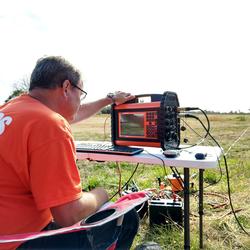Mapping Application Development
Mapping Application Development
Filter Total Items: 41
Groundwater Flow Modeling - Long Island, New York
Numerical models provide a means to synthesize existing hydrogeologic information into an internally consistent mathematical representation of a real system or process, and thus are useful tools for testing and improving conceptual models or hypotheses of groundwater flow systems. The goal of this effort is to develop a regional model for the Long Island aquifer system to simulate changes in water...
Groundwater Sustainability of the Long Island Aquifer System
The U.S. Geological Survey (USGS) has partnered with the New York State Department of Environmental Conservation (NYSDEC) to conduct a comprehensive study of the Long Island aquifer system. The major findings of this investigation include: The location of the boundary between fresh and salty groundwater is much closer to the shoreline than previously thought. The historical onshore saltwater...
Hydrogeologic-Framework Mapping - Long Island, New York
Long Island is underlain by unconsolidated Holocene deposits, glacial deposits of Pleistocene age, and coastal-plain deposits of Late Cretaceous age. These sediments consist of gravel, sand, silt, and clay underlain by crystalline bedrock of early Paleozoic age (figure 2b). The bedrock is relatively impermeable, and forms the base of the groundwater-flow system on Long Island. The geologic and...
Saltwater-Interface Mapping - Long Island, New York
Saltwater intrusion is the most common type of water-quality degradation in coastal-plain aquifers. In coastal areas, the hydraulic head under predevelopment (nonpumping) conditions is higher on land than in the surrounding saltwater embayments; thus, fresh groundwater flows seaward (from areas of high potential to areas of lower potential) and meets saltwater at an equilibrium point (interface)...
Development of a mapper-based Long Island Sound data and research portal (Clearinghouse)
In cooperation with the Long Island Sound Study (LISS) and U.S. Environmental Protection Agency (EPA), the U.S. Geological Survey (USGS) is creating a mapper-based clearinghouse that will provide information on sources of data available throughout the Long Island Sound (LIS) watershed and allow for real-time metadata output and integration into visualization and modeling tools developed through a...
HAIL (Hydrologic Applied Innovations Lab)
HAIL (Hydrologic Applied Innovations Lab)
Bathymetry of New York City’s East of Hudson Reservoirs
Background: The New York City Department of Environmental Protection (DEP) maintains an extensive network of reservoirs and aqueducts for water collection, storage, and transport; it supplies more than one billion gallons of drinking water daily to more than nine million people. The East of Hudson (EOH) network (fig. 1) includes thirteen reservoirs – Amawalk, Bog Brook, Boyd Corners...
Determination of Sources of Water to the Tully Valley Mudboils
Background and Problem Tully Valley is part of the Onondaga Trough, which extends from the Valley Heads Moraine in the south to Onondaga Lake in the north near Syracuse, New York (fig. 1). The Onondaga Trough is filled with a complex sequence of glacial and post-glacial sediments that overlie Devonian carbonate rock and shale and Silurian shale and salt (fig.2). Mudboils, volcano-like...
Geographical Information Systems (GIS)
Geographical Information Systems Information and Data
Lake Ontario Flood Monitoring and Mapping
Problem– Lake Ontario experienced period-of-record (1918-2017) maximum monthly average water levels during May through July 2017. NOAA lake gages recorded instantaneous peaks-of record, 249.2 at Olcott, 249.1 at Rochester, and 249.0 at Oswego and St. Vincent. These high water levels along with wind-generated waves caused flooding of thousands of residences and businesses and the erosion...
Detailed Aquifer Mapping of the Oneonta Area Otsego and Delaware Counties, New York
Introduction The City of Oneonta and surrounding area is the major population center in Otsego County, N.Y. and home to two colleges (SUNY Oneonta and Hartwick College). The public water supply draws on both surface-water and groundwater sources and serves 15,954 people in the City of Oneonta and parts of the surrounding Town of Oneonta (City of Oneonta, 2013). The remaining population...
Long Island - Location and Physical Setting
Long Island, the eastern-most part of New York State, extends east-northeastward roughly parallel to the Connecticut coastline. It is bounded on the north by Long Island Sound, on the east and south by the Atlantic Ocean, and on the west by New York Bay and the East River. Long Island is joined to the mainland specifically, to the Borough of the Bronx, which is one of the five boroughs of New York...












